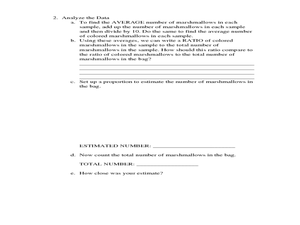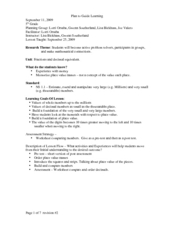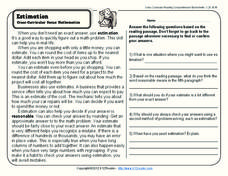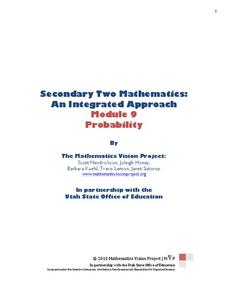Curated OER
Estimate Using Tens
In this estimate using tens worksheet, 2nd graders match three sets of toys with 3 jars by estimating using tens and reading the label on the jar.
Curated OER
Problem-Solving Decisions: Estimates or Exact Answers
In this problem solving worksheet, students examine 2 math word problems taking care to decide whether they should estimate answers or find exact answers
Curated OER
Estimate or Exact?
In this estimating or exact answers worksheet, students sharpen their problem solving skills as they solve 6 story problems.
Curated OER
Find The Best Estimate
In this math worksheet, students find the best estimate by using the skill of rounding. The answers are written in the spaces at the bottom of the page.
Curated OER
Estimate Products
In this estimating products worksheet, learners round factors in problems to the nearest ten and solve. Answers are included on page 2.
Curated OER
Estimated Quotients Are Too Large or Too Small
In this division worksheet, 5th graders use division to find batting averages in 6 word problems. They divide the number of hits by the number of times at bat to find the quotients.
Curated OER
Estimated Distances
In this estimating distances worksheet, students examine a mileage table and respond to 6 questions that require them to use their subtraction skills.
Curated OER
Estimating and Measuring Angles (B)
For this estimating and measuring angles review worksheet, students use their math skills to solve 6 problems that require them to estimate and measure each of the 6 angles.
Curated OER
How Many Critters Live Here? Estimating Wildlife Populations.
Learners examine how wildlife biologists estimate the population of particular species. They work on map construction and population sampling. They use sampling to estimate the population of spiders in a study area or a forest.
Curated OER
Measure to the Nearest Inch: Practice
In this measuring worksheet, students practice measuring length to the nearest inch by first estimating and then measuring the illustrated objects. In the second set, students use a ruler to measure the given lengths and draw a line for...
Curated OER
Estimating Deer Population
Students calculate the deer population using proportion. In this algebra lesson, students apply the concept of ratio and proportion to real life scenario.
Curated OER
Fractions and Decimal Equivalents: Fifth Grade
Sometimes a skeleton is all you get. This lesson outline provides teachers with a basic lesson flow. Pupils will pre-test, order place value names, use manipulatives, and build and compare numbers. How this is to be done is not...
Curated OER
Estimating With Fire
Students solve problems with percents, decimals and fractions. In this algebra lesson plan, students convert between fractions, percents and decimals. They estimate their answers and calculate their answer.
Curated OER
Estimating Sums and Differences
In this estimation of sums and differences worksheet, 7th graders solve 20 different problems that are related to estimation of numbers. They add or subtract each problem as shown. Then, students estimate the sums and differences for...
K12 Reader
Estimation
When is it a good idea to use estimation? Learn about estimation and rounding with a reading comprehension lesson. After kids read a passage about estimation, they answer five comprehension questions on the other side of the page.
K12 Reader
Estimation
Teach your class a thing or two about making educated mathematical guesses. Learners read a passage that explains estimation and approximate and exact answers. They then respond to five questions about and related to the text.
National Research Center for Career and Technical Education
Business Management and Administration: Compound Interest - A Millionaire's Best Friend
Many math concepts are covered through this resource: percentages, decimals, ratios, exponential functions, graphing, rounding, order of operations, estimation, and solving equations. Colorful worksheets and a link to a Google search for...
Statistics Education Web
It Creeps. It Crawls. Watch Out For The Blob!
How do you find the area of an irregular shape? Class members calculate the area of an irregular shape by finding the area of a random sampling of the shape. Individuals then utilize a confidence interval to improve accuracy and use a...
Illustrative Mathematics
How Thick Is a Soda Can I?
The humble soda can gets the geometric treatment in an activity that links math and science calculations. After a few basic assumptions are made and discussed, surface area calculations combine with density information to develop an...
EngageNY
Rational Exponents—What are 2^1/2 and 2^1/3?
Are you rooting for your high schoolers to learn about rational exponents? In the third installment of a 35-part module, pupils first learn the meaning of 2^(1/n) by estimating values on the graph of y = 2^x and by using algebraic...
Berkshire Museum
Adopt a Schoolyard Tree
Help young scientists connect with nature and learn about trees with a fun life science lesson. Heading out into the school yard, children choose a tree to adopt, taking measurements, writing descriptions, and drawing sketches of it in...
Mathematics Vision Project
Probability
Probability, especially conditional probability, can be a slippery concept for young statisticians. Statements that seem self-evident on the surface often require a daunting amount of calculations to explicate, or turn out to be not so...
Mathematics Vision Project
Module 8: Probability
It's probably a good idea to use the unit. Young mathematicians learn about conditional probability using Venn diagrams, tree diagrams, and two-way tables. They also take into consideration independence and the addition rules.
Math Mammoth
Review 1
For this mathematics worksheet, 3rd graders write the numbers for each problem. Then they write each in expanded form and the numbers from least to greatest. Students also estimate first by rounding the numbers to the nearest hundred.

























